Revealing the science of First Nations fermentation processes
It is well documented that First Nations people knew how to make alcoholic drinks from sweet juices and nectars well before the European invasion, but little is now known about the processes involved, the yeasts and bacteria at work, or the chemistry, taste and smell of the plants and finished products, but now the University of Adelaide is investigating these traditional practices.
A 30 year study of drug and alcohol research rejects the claim First Nations people have a genetic predisposition to alcohol abuse, so what's the legacy of these inaccurate perceptions? Researcher Dr Maggie Brady says these unsubstantiated judgements have engendered a sense of hopelessness and fatalism in the Indigenous community's approach to alcohol problems.
Maggie Brady is a researcher in the ANU's Centre for Aboriginal Economic Policy Research. She has devoted most of her career researching the effects of substance abuse on indigenous communities. This talk is based on her most recent publication "First Taste: How Indigenous Australians Learned About Grog".
The cultural heritage of alcohol goes back thousands of years before colonisation. Contrary to all teachings, the first alcohol wasn't brought here by boat by the colonisers, it came from Aboriginal people fermenting their own special drink from tree sap and flowers.
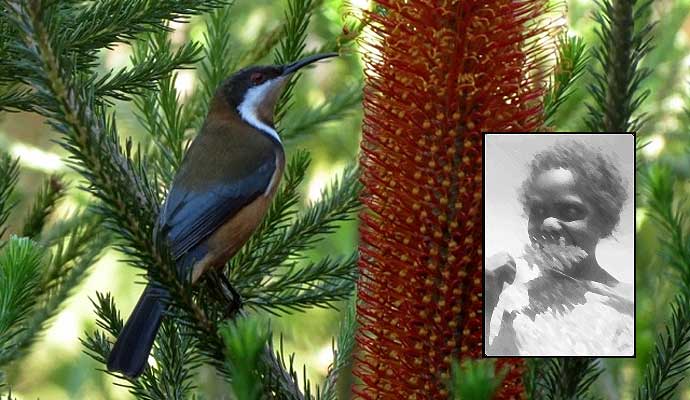
Bottle-brushes, or Banksias, provided First Nations people with a fermented drink in the Sydney region. The brushes, which are just long spikes of very crowded flowers, that produce large quantities of honey, were soaked in water, and the sweetened fluid allowed to ferment.
October 24, 2016
Wine researchers at the University of Adelaide are investigating the traditional practices of Australian Aboriginal people in producing fermented beverages and foods.
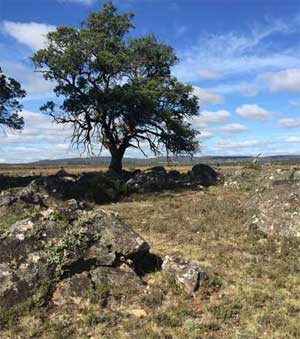
(Image: John Reid)
Although referred to in early European texts, little is known about the processes involved, the yeasts and bacteria at work, or the chemistry, taste and smell of the plants and finished products.
Led by Professor Vladimir Jiranek, Professor of Oenology and Director of the ARC Training Centre for Innovative Wine Production, the research will focus initially on fermentations of cider gum sap (from Tasmania), nectar from Banksia and other native blossoms (from various locations) and quandong roots (from South Australia).
"Although these historic accounts mention such fermentations by Aboriginal people, as far as we can tell none of these processes have been characterised scientifically," says Professor Jiranek.
"Preliminary discussions with members of Aboriginal community groups and historic texts to date have pointed us towards the steeping of nectar-laden flowers such as Banksia or extracts from pandanus nuts in water, which could be then set aside for varying lengths of time. Such materials would undoubtedly ferment to some extent, changing the sensory properties and yielding alcohol, although probably at quite low levels – less than beer."
"Another product arises from the cider gum, a Eucalypt limited to isolated parts of Tasmania which readily produces a sugar-rich sap that was actively sought out by Aboriginal people as well as the local fauna.
"Allowing this material to stand for some time would result in a fermented, cider-like beverage, albeit again of modest alcohol content."
Professor Jiranek says the project represents an opportunity to comprehensively document these and related practices across Australia. The study will improve understanding of the use of native plants and their cultural context.
"There is an important historical and anthropological aspect to the project," Professor Jiranek says. "Some of these processes are not being practised anymore, but there may at least still be people with living memory of them. We're keen to record what we can while still possible."
"The work may also reveal that novel organisms are involved that are unique to Australia, making this an opportunity to identify some new species of yeast and bacteria, perhaps with interesting new properties. We will also characterise the composition of the saps, nectars and various extracts as fermentation substrates while the Australian Bioactive Compounds Centre will determine if bioactive compounds are also present," he says.
Provided by: University of Adelaide - Our Source: Phys.org
19th century Newspaper Reports
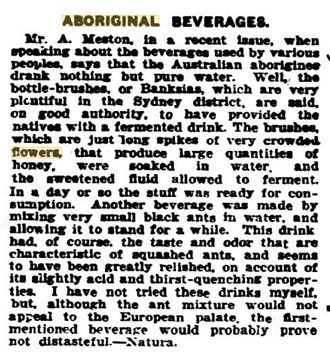 |
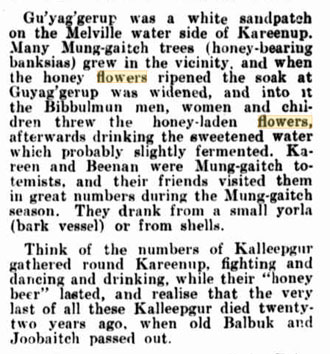 |
|
| The World's News (Sydney) 8 Sep 1923 p8 - Link ABORIGINAL BEVERAGES (extract) Mr. A. Meston. in a recent issue, when speaking about the beverages used by various peoples, says that the Australian aborigines drank nothing but pure water. Well, the bottle-brushes, or Banksias, which are very plentiful in the Sydney district, are said, on good authority, to have provided the natives with a fermented drink. The brushes, which are just long spikes of very crowded flowers, that produce large quantities of honey, were soaked in water, and the sweetened fluid allowed to ferment. In a day or so the stuff was ready for consumption. Another beverage was made by mixing very small black ants in water, and allowing it to stand for a while. This drink had of course, the taste and odor that are characteristic of squashed ants, and seems to have been greatly relished, on account of its slightly acid and thirst-quenching properties. I have not tried these drinks myself, but, although the ant mixture would not appeal to the European palate, the first mentioned beverage would probably prove not distasteful. - Natura. |
Western Mail (Perth) Thu 4 Jul 1929 p70 - Link ABORIGINAL PERTH by Daisy M. Bates (extract) Gu'yag'gerup was a white sandpatch on the Melville water side of Kareenup. Many Mung-gaitch trees (honey-bearing banksias) grew in the vicinity, and when the honey flowers ripened the soak at Guyag'gerup was widened, and into it the Bibbulmun men, women and children threw the honey-laden flowers, afterwards drinking the sweetened water which probably slightly fermented. Kareen and Beenan were Mung-gaitch totemists, and their friends visited them in great numbers during the Mung-gaitch season. They drank from a small yorla (bark vessel) or from shells. Think of the numbers of Kalleepgur gathered round Kareenup, fighting and dancing and drinking, while their "honey beer" lasted, and realise that the very last of all these Kalleepgur died twenty two years ago, when old Balbuk and Joobaitch passed out. |
Strong Alcoholic beverages were known to Aboriginal people in Northern Australia before colonisation
'Indigenous Drinking Myths Dispelled' ABC Radio (Brisbane) 19 September 2008
Dr Maggie Brady from Australian National University is a veteran of 30 years drug and alcohol research and rejects the claim Aborigines have a genetic predisposition to alcohol abuse. She published 'First Taste: How Indigenous Australians Learned About Grog' was funded by the Alcohol Education and Rehabilitation Foundation.
"These are long standing beliefs that date back to colonial times when it was thought native people all over the world were particularly vulnerable to addiction, but there is no evidence of this.
Ms Brady said that Europeans were the first to introduce distilled spirits like whiskey, rum and gin to people living in the southern parts of Australia. But in the north, Indonesians had been trading alcohol with Aborigines for more than a hundred years before Captain Cook landed in Botany Bay.
"I've also found strong evidence of Aboriginal people making their own fermented drinks before any contact with outsiders," Dr Brady said.
"It's very well documented they did know how to make alcoholic drinks from sweet juices and nectars in the natural environment and although they were very mild they were certainly enough to alter mood."
So what's the legacy of these inaccurate perceptions? Dr Brady says this has engendered a sense of hopelessness and fatalism in the Indigenous community's approach to alcohol problems.
"If people treating someone with an alcohol addiction feel there is an inherent weakness that would be a very negative influence and would make people question the point of treatment," she said.
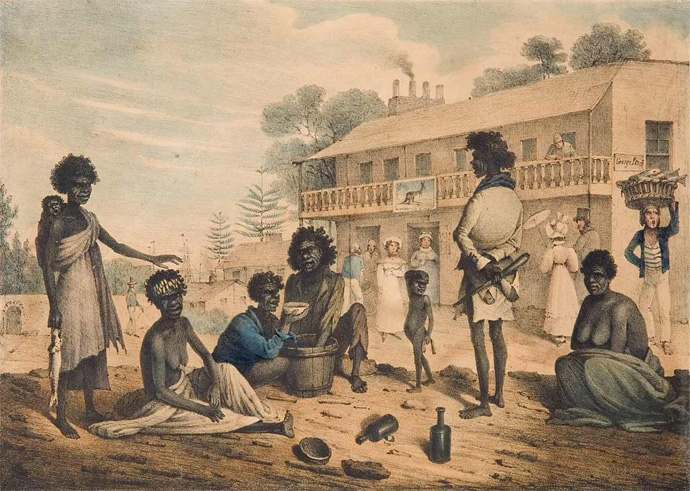
This scene of First Natons people dispersed from country and sitting around in the street drinking alcohol while fashionably dressed townsfolk look on was intended to be taken by colonial audiences as amusing. It references grog culture in the early colonial years - 'grog' is a mid-18th-century colloquial term that means (usually cheap) alcohol; two men are shown gathered around a bucket of 'bull', which was a cheap source of alcohol made by soaking and fermenting old sugar bags.
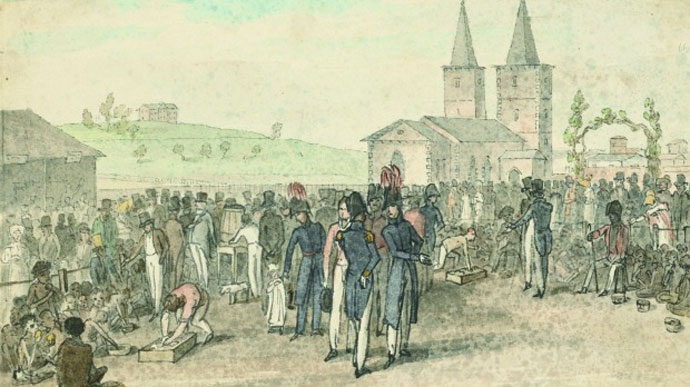
Governor Lachlan Macquarie introduced the annual 'Native Feasts' in 1814 to promote the Native (assimilation) Institution to Aboriginal people, who were invited to town to gather near St John's Cathedral and were given Ale, bread and roast beef. Soon after, a site next to the church became the first institute for stolen children, probably the building on the left side of the image. Read More


